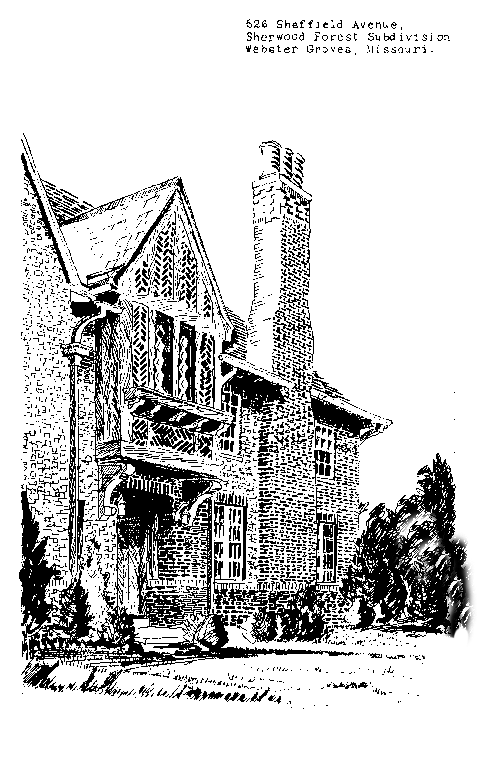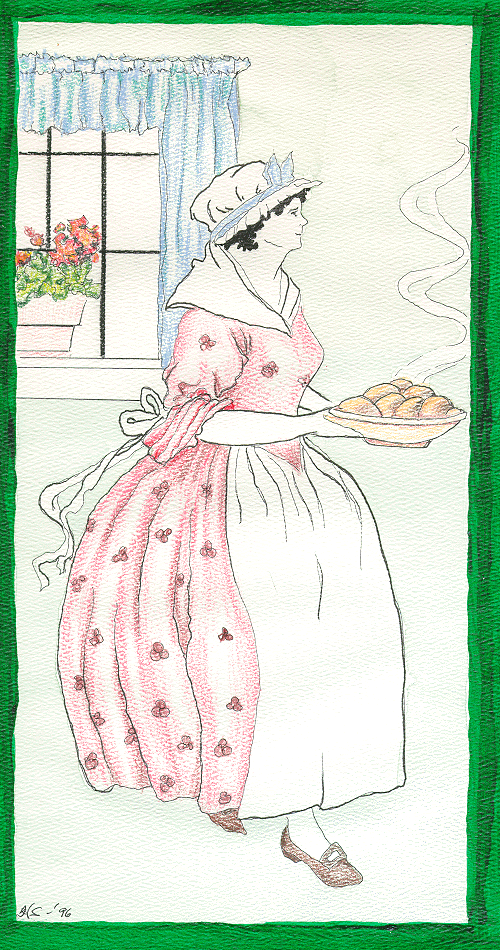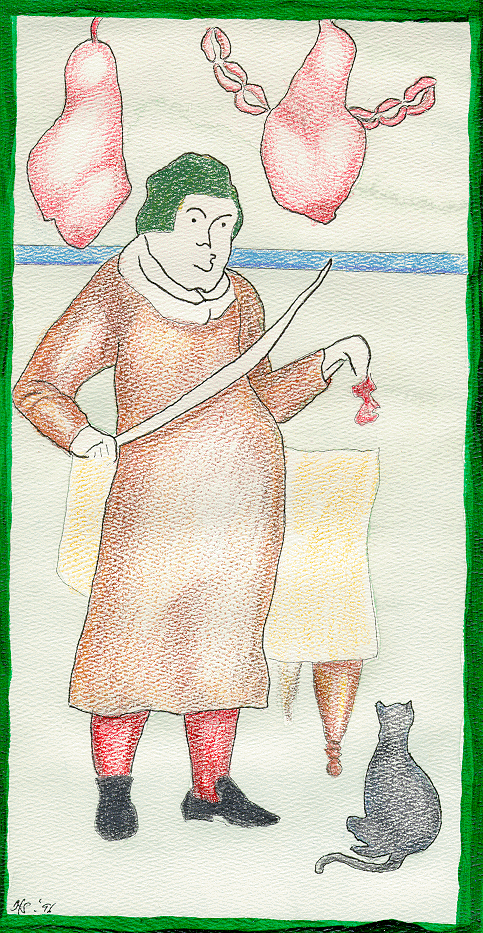- Drawing of 526 Sheffield House, Webster Groves

In 1980, Marilyn and I visited St. Louis, and went to some of the old family places. On a hunch, and bearing a copy of the drawing of the house, I knocked on the door at 526 Sheffield, and the then owner let us in. She showed us all around, was very interested in the history, and I took snapshots of the stained glass windows in the dining room doors. Later I did drawings of them, which are shown here.
My drawings of stained-glass windows in dining room of 526 Sheffield

A servant maid carrying a steaming hot bowl of potatoes.

A butcher holds up a piece of meat while a gray cat looks up hopefully from below. - Painting by HS of snow scene, Taylor 1942

In the early 1990's, Mathilda and Merl visited the Seattle Schiffmans (Harold, Marilyn and Tim) in a visit combined with a Smithsonian Tour of Art Glass in Seattle, especially the Pilchuck studios of Dale Chihuly and his associates. Photographs taken by Merl in this album, and other images downloaded from internet sites in the text.

Introduction: Dale Chihuly and Studio Art Glass

A prodigiously prolific artist whose work balances content with an investigation of the material's properties of translucency and transparency, Chihuly began working with glass at a time when reverence for the medium and for technique was paramount. A student of interior design and architecture in the early 1960s, by 1965 he had become captivated by the process of glassblowing. He enrolled in the University of Wisconsin's hot glass program, the first of its kind in the United States, established by Studio Glass movement founder Harvey K. Littleton. After receiving a degree in sculpture, Chihuly was admitted to the ceramics program at the Rhode Island School of Design, only to establish its renowned glass program, turning out a generation of recognized artists.
Influenced by an environment that fostered the blurring of boundaries separating all the arts, as early as 1967 Chihuly was using neon, argon, and blown-glass forms to create room-sized installations of organic, freestanding, plantlike imagery. He brought this interdisciplinary approach to the arts to the legendary Pilchuck School in Stanwood, Washington, which he cofounded in 1971 and served as its first artistic director until 1989. Under Chihuly's guidance, Pilchuck has become a gathering place for international artists with diverse backgrounds. His studios, which include an old racing-shell factory in Seattle called The Boathouse and now buildings in the Ballard section of the city and in Tacoma, Washington, have become a mecca for artists, collectors, and museum professionals involved in all media.
Stylistically during the past forty years, Chihuly's sculptures in glass have
explored color, line, and assemblage. Although his work ranges from the single vessel
to indoor/outdoor site-specific installations, he is best known for his multipart
blown compositions. These works fall into the categories of mini-environments
designed for the tabletop and large, often serialized forms displayed in groupings on
pedestals or attached to specially engineered structures that dominate large exterior
or interior spaces.
Chihuly and his teams have created a wide vocabulary of blown forms, revisiting and refining earlier shapes while at the same time creating exciting new elements, such as his recent Fiori, all of which demonstrate mastery and understanding of glassblowing techniques. Earlier forms, such as the Baskets, Seaforms, Ikebana, Venetians, and Chandeliers from the late 1970s through the 1990s, continue to reappear with fresh variations and within new contexts.
Since the early 1980s, all of Chihuly's work has been marked by intense, vibrant color and by subtle linear decoration. At first he achieved patterns by fusing into the surface of his vessels “drawings” composed of prearranged glass threads; he then had his forms blown in optic molds, which created ribbed motifs. He also explored in the Macchia series bold, colorful lip wraps that contrasted sharply with the brilliant colors of his vessels. Finally, beginning with the Venetians of the early 1990s, elongated, linear blown forms, a product of the glassblowing process, have become part of his vocabulary, resulting in highly baroque, writhing elements.
Chihuly's work is strongly autobiographical. His fascination with abstracted flower
forms, reminiscent for him of his mother's garden in Tacoma, has been discussed in
depth in the literature. Likewise, series such as his Seaforms, Niijima Floats, and
even the Chandeliers allude to his childhood in Tacoma, marked by his love of the sea
and his recognition of its importance to the economy of the Pacific Northwest. Even
in the few instances in which the artist has chosen to respond to earlier historical
decorative arts forms, the imagery has personal significance. The Basket series, for
instance, developed out of the woven Northwest Coast Indian baskets that Chihuly saw
in 1977 with his friend the sculptor Italo Scanga and with the sculptor James
Carpenter at the Tacoma Historical Society.
Over the years the artist has created a number of memorable installation exhibitions, including Chihuly Over Venice (1995–96), Chihuly in the Light of Jerusalem 2000 at the Tower of David Museum of the History of Jerusalem (2000), Chihuly in the Park: A Garden of Glass at Chicago's Garfield Park Conservatory (2001–2), the Chihuly Bridge of Glass in Tacoma (2002), and Mille Fiori at the Tacoma Art Museum (2003). These installations confirm the artist's sensitivity to architectural context and his interest in the interplay of natural light on the glass that exploits its translucency and transparency. Recent situations have heightened this effect, since the buildings Chihuly has selected as sites for the works have themselves been of glass.
While elements of the earlier installations allude to natural phenomena such as icicles and vegetation, gardens provide the dominant theme in Chihuly's most recent ones. Sites that include Chicago's Garfield Park Conservatory and the Franklin Park Conservatory in Columbus, Ohio, as well as future projects at the Atlanta Botanical Gardens and Kew Gardens, London, enable the artist to juxtapose monumental, organically shaped sculptural forms with beautiful landscaping, establishing a direct and immediate interaction between nature and art. Moreover, Chihuly's most recent installations at the Tacoma Art Museum and at Marlborough Gallery, New York, reveal the artist's progression toward a logical next direction: installations that are gardens themselves. In a sense, Chihuly has come full circle; now using his mature vocabulary, he captures in these installations the joie de vivre of the plantlike forms of his early neon environments.
A dominant presence in the art world, Dale Chihuly and his work have long provoked considerable controversy as part of the art/craft debate. However, with exhibitions at such major museum venues as the Victoria and Albert in London (2001), there can be little doubt that his lasting contribution to art of our times is an established fact.
Text by Davira S. Taragin
Director of Exhibitions and Programs
Racine Art Museum
Adapted from the exhibition catalogue Dale Chihuly 2002,
Grounds for Sculpture, Hamilton, New Jersey